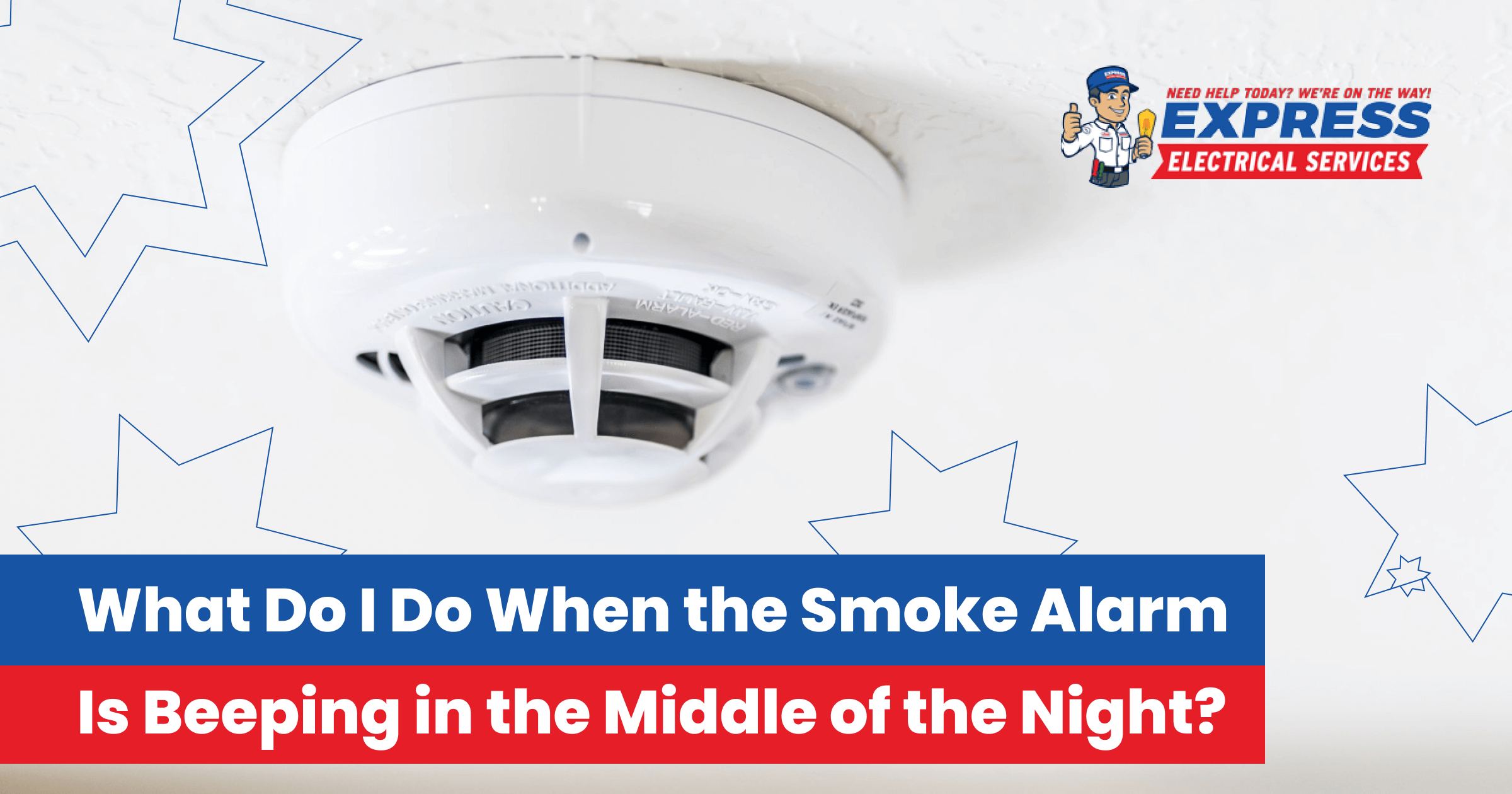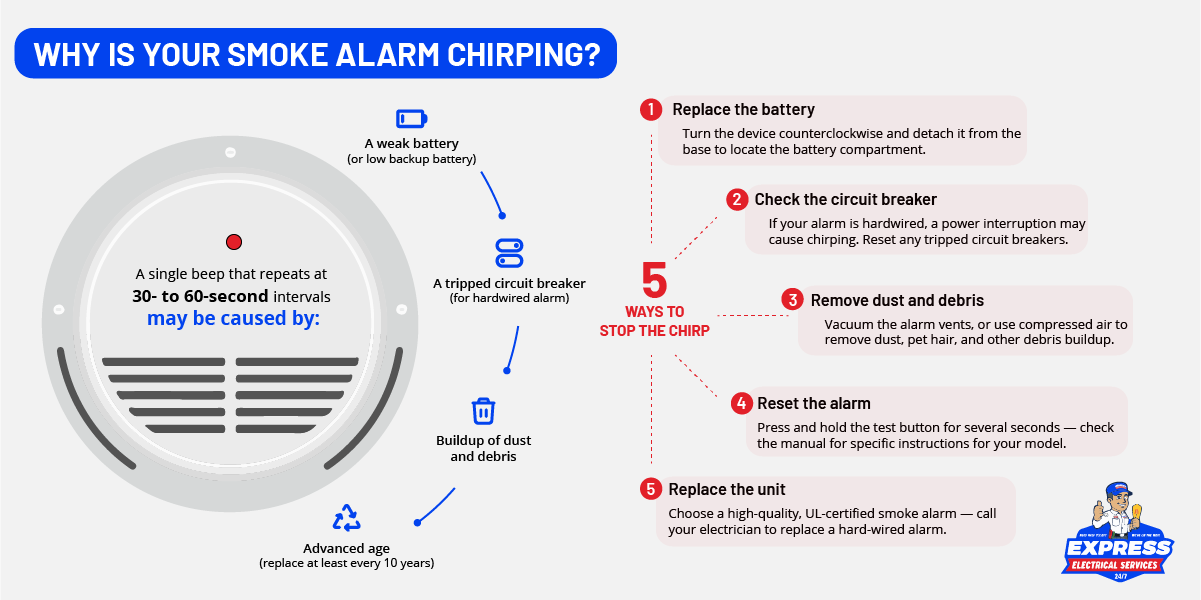What Do I Do When the Smoke Alarm Is Beeping in the Middle of the Night?

Smoke detectors are designed to make a loud noise if there’s smoke or fire in your home. This is intended to wake up occupants so they can get to safety. But hearing a smoke alarm beeping in the middle of the night isn’t always an emergency. There are other reasons you might hear your smoke alarm at 4 a.m. Some of these are easy to fix; others may require a professional electrician to resolve.
Why Is My Smoke Alarm Beeping If There’s No Fire?
A smoke detector is designed to alert you when its battery is weak. If so, the battery releases more power, which increases resistance in the unit, which is further increased by drops in room temperature at night. Thus, you hear the low battery chirp. Once your home starts warming up in the morning, the noise might stop.
When you hear your smoke alarm, proceed depending on the following situations:
The Alarm Sounds Continuously
- Look for evidence of smoke or fire in your home.
- Verify the source of the noise; burglar and carbon monoxide alarms can also beep.
- Check for dust or dirt and clean the alarm if necessary.
- Replace the alarm if it’s 10 years old or older.
- Make sure the alarm is positioned per the manufacturer’s guidelines.
- See if the alarm was exposed to water, grease, or paint.
The Alarm Is Intermittent
- Replace the smoke detector’s battery with the correct type and in the right position.
- Look at the manufacturing date; if it’s near or more than a decade old, install a new alarm.
- Check for damage or evidence of a fault in the alarm.
Also, note that a hardwired smoke detector can beep if its backup battery is low in power.
How Do I Stop a Smoke Alarm from Beeping in the Middle of the Night?

Stopping a smoke alarm from beeping is often simple. Get a step ladder and carefully reach for the alarm. Pressing the “Test/Silence” button on the front of the unit should stop it from beeping or chirping. If this doesn’t work, grasp the device and turn it counterclockwise. It should detach from the base so you can open the battery compartment in the back. Remove and replace the battery to see if it caused the issue.
A hardwired device can be removed by loosening the alarm wire screws with a screwdriver (or, by unclipping the wire connector). Be careful not to touch the exposed copper ends of the low-voltage lines. Do not leave the smoke detector disabled. If you can’t find a permanent solution, contact a local electrician who can help. Nonetheless, there are other smaller issues to look for, including:
- Security Peg: Depending on the alarm, you’ll need to pull out a small security peg to open the battery drawer. Make sure to push this back after changing the battery.
- Battery Pull Tab: Hardwired models with a 10-year sealed backup battery have a pull tab that must be removed once the alarm receives AC power.
- Battery Cover: Make sure the battery drawer is closed and the battery fits in the slot. Otherwise, it won’t make contact with the terminals. Other models may have a lid that must be properly closed and mounted.
- Obstructed Terminal: Corrosion or even dust or pollen obstructing the battery terminals can block the connection, preventing the smoke alarm from working properly. Remove the batteries, carefully brush any debris off the terminals, and then reinsert them.
- Temperature/Humidity Variations: If the temperature becomes too cold in an unheated area, electrical charges can fluctuate. After a shower or during cooking, hot, humid air may be released and cause a false alarm.
- Airborne Particles: Particles can affect a light-sensitive smoke alarm by blocking the light beam, causing the unit to start beeping. In this case, clean the unit to remove any particles that may be interfering with it and to ensure your safety.
- Save Errors: Smart alarms often save errors in their processor; these can add up and trigger a false alarm. Restarting the system will delete the saved errors so they won’t interfere with normal operation.
How Do I Know If an Electrical Problem Is Affecting My Smoke Detector?
Hardwired smoke detectors can trigger if the circuit breaker it’s connected to trips. Usually, some lights or devices won’t work, as local fire codes often require a shared circuit, so you’ll know that the breaker tripped. To fix the problem:
- Locate the breaker
- Turn the breaker switch off
- Wait a few minutes before switching it back on.
- Reset the alarm by pushing and holding the test button.
The alarm should sound and then stop, meaning the smoke detector is working.
An electrical surge can also trigger a smoke alarm. It can be challenging to locate the affected unit as the entire circuit may be activated. Locate the appropriate breaker and shut it off. Follow the process above to turn it back on and, if the problem isn’t resolved, call an electrician.
How Do I Replace the Battery in a Smoke Alarm?
A residual charge may remain in the smoke alarm even when you remove the old battery. Depending on the unit, unscrew or unclip the battery panel or slide out the battery drawer. Then remove the battery. Hold the test button for 15 seconds before replacing the battery (making sure the positive and negative sides match with the corresponding terminals). If the alarm is hardwired, reconnect the power cable and reinstall the device.
How Often Should I Clean My Smoke Alarm?
Clean your smoke alarm every six months. If the sensors are covered in dust, the smoke alarm may chirp. Dust can also interfere with the battery connection, causing the unit to not work. You can wipe down the alarm with a soft cloth. Compressed air is handy for clearing dust out of tight spaces, or you can use a vacuum cleaner with a soft brush attachment to gently clean the device.
Why Does My Smoke Alarm Make Different Types of Sounds?
Smoke alarms can make different types of sounds:
- Continuous beeping means the device (or another it is connected to) has detected smoke in your home.
- A single beep about every 30 seconds to a minute can mean the battery is low, the sensors are dirty, or the unit needs to be replaced.
- Multiple beeps can indicate a malfunction, or if the unit can detect carbon monoxide (CO), high levels of the gas may be present. Check the manual to determine what the sound means.
When Should I Replace My Smoke Alarm?
Smoke alarms are designed to last 10 years. Replace a device if it has reached this point or there are other indications it’s not functional. If you have a battery-operated unit, consider installing hardwired alarms with backup batteries (in case the power fails). Look for newer devices with photoelectric and ionization sensors that effectively sense smoke and fires and additional features like CO detection, alarm strobe lights, LED emergency lights, and vacuum-sealed batteries.
Contact Express Electrical Services
If your smoke alarm is beeping in the middle of the night, you can’t find the cause, or aren’t able to correct it, our licensed electricians can troubleshoot it and make repairs. Our Southern California customers depend on us to test, repair, and replace smoke alarms to keep their homes and families safe. You can reach us 24/7 for emergency service. To request assistance, call (855) 976-9049.

I have 4 Putogesafe smoke detectors daisychained and installed a few months ago. All was fine until today, when we heard a single chirp. We checked the house and all was fine, and approximately 3 hours later it happened again. Just a single chirp. Any ideas why this is happening?
My smoke alarm that was installed by penelec is beeping. How to I stop
A smoke alarm beeping in the middle of the night is often a low battery warning or an indicator of a maintenance issue. Start by replacing the battery, cleaning the unit, or resetting it. If the problem persists, the detector might need to be replaced, especially if it’s over 10 years old.
For professional installation and maintenance of smoke detectors, Ataraxis Solutions provides expert services to ensure your fire safety systems are always reliable.
Visit ataraxis-solutions.com to learn more about keeping your property safe with professional-grade fire detection systems